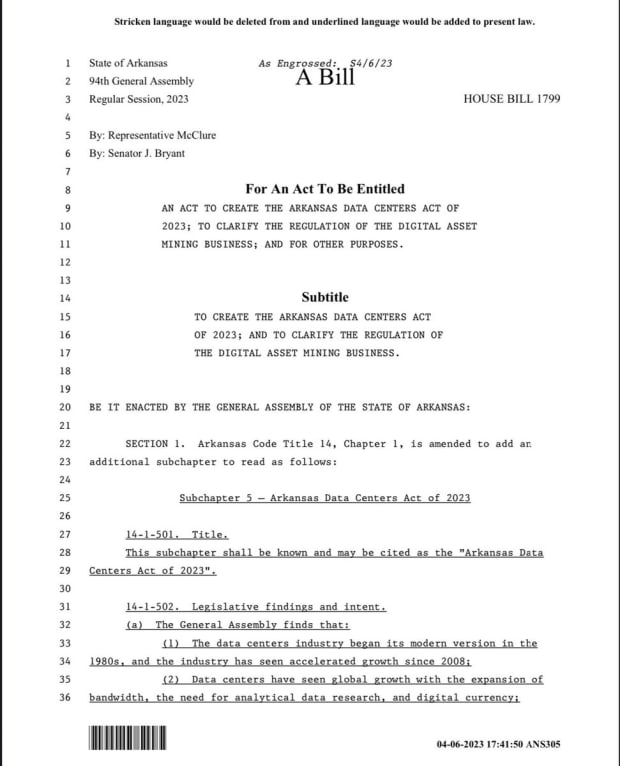We Hear You: Bitcoin Mining Noise Pollution Is A Solved Problem
Public complaints around bitcoin mining noise pollution are growing, but miners have plenty of solutions at their disposal. Let’s use them.
Bitcoin mining is loud.
Anyone reading that sentence who has not visited an operational mining farm is probably imagining a loud restaurant or a running air-conditioning unit. But in this context, “loud” actually means an almost ungodly cacophony of spinning fan blades producing a noise level akin to a fighter jet. Mining gives new meaning to “sound money.”
A single bitcoin mining machine produces between 70 to 90 decibels (dB) of sound. Decibel levels scale logarithmically, so if one relatively-quiet machine produces 75 dB, then 10 similar machines produce 85 dB and 100 machines produce 95 dB. For comparison, the average nightclub maintains a noise level of 98 dB — almost deafening.
Bitcoin miners are accustomed to this noise, and responsible site operators always take necessary precautions to protect their hearing while working inside a mining building. But a mining farm’s noise doesn’t always stay contained within the walls of its buildings, and mining “noise pollution” is an increasingly popular topic in mainstream news headlines and letters to regulators penned by environmental advocacy groups.
What these outlets often don’t understand, however, is that bitcoin mining noise pollution is a solved problem. Miners have many options available to them for noise control, which can be effective at both large-scale industrial bitcoin farms and small at-home mining setups. This article explores the status quo’s concern with mining noise and ways bitcoin miners can mitigate noise pollution.
People Complain About Bitcoin Mining Noise
Crime, carbon emissions and con artists are typically the preferred talking points for Bitcoin critics. Historically, noise pollution is rarely mentioned. But now complaints about mining noise make headlines more often than the average bitcoin investor realizes, and these critiques are even included in petitions to federal regulators.
Noise and other mining externalities turned a small town in North Carolina against its local bitcoin miners. Residents in a rural Ohio community complained to their city’s planning commission about noise levels from a nearby mining facility. As did Niagara Falls residents. And residents of Sherbrooke, Quebec and residents of Labrador City, near Quebec.
After becoming home to bitcoin miners, a Montana county saw its commissioners vote unanimously to pass a resolution with new rules for current and future mining operations, including new zoning rules for noise requirements. Similar, rapid, noise-related zoning changes came to a small Colorado town that became home to a mining business. A Tennessee judge ruled that noise from a bitcoin mining site violated local zoning laws after months of complaints from local residents.
Even outside of North America, bitcoin mining farms are framed as difficult neighbors. A Norway-based mining company faced permitting issues and serious local opposition all due to the noise from its several sites. Animosity was so intense that the company received a bomb threat over noise from its mining activities.
These headlines are rarely discussed in Bitcoin-focused circles of Twitter and Reddit, but other people pay attention to them. One prominent example came from 23 congresspersons who recently signed a letter addressed to the U.S. Environmental Protection Agency (EPA) asking for close evaluation and stricter regulation of bitcoin mining facilities. Noise was mentioned in three of the letter’s eight paragraphs.
But Bitcoin Mining Noise Is A Solved Problem
Every mining operation — from 10 online machines to 10,000 — can employ a variety of products and strategies to limit noise output. Noise complaints about bitcoin mining farms will probably multiply before they start to subside. But this particular problem has many possible solutions. Here are a few:
Location is one of the most obvious solutions for noise. If possible, relocate to more remote areas. For example, after facing noise complaints from neighbors near some of its mining sites, Bitfarms announced its plans to select more remote locations for new sites. The public Canadian mining company also implemented advanced sound monitoring equipment that makes operational adjustments to reduce sound levels in real time.
Other bitcoin mining companies, however, have opted for slightly less technical solutions for their noise. One natural-gas-powered, off-grid mining site, for example, erected rows of hay bales behind its on-site mining facilities to shield nearby residents from the noise. For mining facilities without easy access to hay bales, the possibilities for alternate tools and materials for noise reduction are nearly endless, including soundproof tiles, various acoustic barriers, prefabricated noise-dampening enclosures, noise insulation foam and more.
Depending on how the setup is architected, home miners could annoy their closest neighbors with mining noise, too — even with a few machines. In these situations, tools like the Black Box from Upstream Data are essential. This fire-and-weather-resistant enclosure cuts a machine’s noise level in half.
Some retail-focused bitcoin mining companies are also publishing guides and educational materials on noise reduction for the benefit of their clients. For example, Kaboomracks, the bitcoin industry’s leading hardware resale marketplace, produced a step-by-step video tutorial on noise reduction. Compass Mining, a Bitcoin startup offering hosted mining services, also published a home mining guide that includes a section with tips for noise management.
Immersion cooling is another sure-fire technique for not just reducing noise, but eliminating it altogether. After all, a mining machine’s highest decibels are produced by the thing that keeps it from overheating and melting: high-velocity fans. Remove the fans, submerge the hardware in dielectric fluid and the noise disappears. Analysis on immersion cooling from Braiins Mining corroborates this.
“The removal of the fans and density of the fluid practically eliminates the noise,” a recent article from the company reads.
Sometimes, the key to massive noise reduction is as simple as installing a different fan. Jesse Peltan, CTO at bitcoin mining and energy infrastructure company HODL Ranch, demonstrated this in a video he shared on Twitter. Peltan shows an old-generation bitcoin mining machine with a factory stock fan running at 78 dB compared to the same machine with a Noctua fan running at 53 dB — a difference of 25 dB!
It’s Not Just A Bitcoin Problem
Bitcoin mining is noisy. But mining farms are not the only type of computing infrastructure facilities receiving noise complaints. Noise pollution is an inherent problem for traditional data centers, too. And just like a bitcoin mine, noise levels of 90 dB or higher are common at most data centers.
Atlantic writer Bianca Bosker appeared on a technology podcast a couple of years ago to explain why data centers rarely make for good neighbors. The conversation never mentioned bitcoin, but it might as well have. The episode was brilliantly titled: “Your ‘Cloud’ Data Is Making Noise On The Ground.” Magic internet money also makes plenty of noise on the ground.
Data center noise levels make headlines, too. Residents in Chandler, Arizona complained to local police about the incessant noise coming from a data center near their neighborhood, according to a report by The Arizona Republic. Chicago residents also complained to everyone, from their building supervisors, to the mayor’s office, to the Department of Health, about intolerable noise coming from a local data center, according to ABC News.
It’s also not a surprise that traditional data centers use some of the same techniques available to bitcoin miners for noise reduction. For example, liquid cooling offers near silence both for data centers and bitcoin mines. Other data centers have sound-deadening acoustic tiles installed on their walls to knock down noise levels.
Bitcoin Miners Can Spike The Noise Narrative
Bitcoin mining is loud, but mining noise is easily manageable. And for immersion-cooled facilities, the noise is gone altogether. How seriously regulators like the U.S. EPA will take public complaints about mining noise pollution is an open question, but the number of headlines about mining noise seems to be growing, not dwindling.
Miners can spike this narrative before it becomes troublesome by implementing one or more of the many easy solutions for better noise management. Bitcoin mining noise is a solved problem, and mining operators should treat it as such.
This is a guest post by Zack Voell. Opinions expressed are entirely their own and do not necessarily reflect those of BTC Inc or Bitcoin Magazine.









